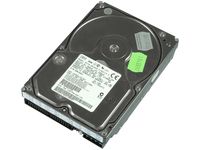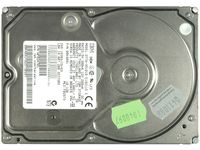USB Thumb Drive Vs. Hard Drive
Hard Drive: IBM DTTA Series, 10 GB ATA/33
The DTTA-series is an old IBM design, made before IBM became Hitachi’s Global Storage Technology division. It was designed for high-performance desktop PCs, entry-level servers, and entry level-workstations. Remember that this was in 1998, when the server/workstation segment was still exclusively dominated by expensive SCSI hardware, and Serial ATA was not yet available.
This drive utilized the fastest interface that was available at that time: UltraATA/33, or UltraDMA/33 as it was called back then. The DTTA family consisted of several models offering capacity points of 3.2 GB, 4.3 GB, 6.4 GB, 8.4 GB, 10.1 GB (this is the one we used for testing), 12.9 GB, and 16.8 GB. The DTTA-351010 10.1 GB model is a three-platter drive, although the family is based on up to five platters for the largest 16.8 GB model.
Performance: Nice Back Then, Weak Today
All of the drives spin at 5,400 RPM, which wasn’t common back in 1997/1998, and all offer a 464 KB cache memory. Performance-enhancing feature such as Native Command Queuing (NCQ) were not available at that time. The drives were rated at average read seek times of 9.1 ms, which translates into an effective average access time of 15.5 ms—this is as quick as a 5,400 RPM 2.5” notebook drive is today.
We found that looking at the transfer rates vs. I/O performance to be the really interesting part. While the interface is capable of delivering up to 31.5 MB/s, the physical read or write performance was about 12.5 MB/s, and drops to 4.5 MB/s write and 6.8 MB/s read throughput by the end of the physical medium. This is about as much as an average SD or CompactFlash card delivers, and less than an average USB 2.0 flash thumb drive.
The I/O performance results tell a different story, however, as the DTTA hard drive outperforms the theoretically-faster USB flash drive by a considerable margin once write operations are involved. Although modern hard drives deliver two to four times better I/O performance than the IBM DTTA-351010, the hard drive still is the much faster choice for this type of workload than the Super Talent Pico-C Gold 8 GB drive, whose bottleneck seems to be the multi-level cell (MLC) flash memory.
Get Tom's Hardware's best news and in-depth reviews, straight to your inbox.
Current page: Hard Drive: IBM DTTA Series, 10 GB ATA/33
Prev Page Hard Drive vs USB Thumb Drive Next Page USB Flash Drive: Super Talent Pico C Gold USB 8 GB

